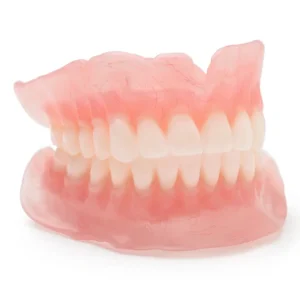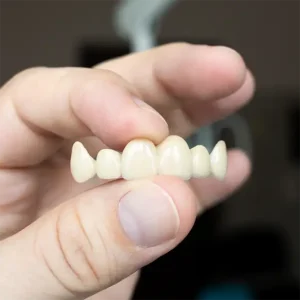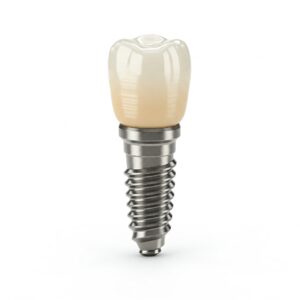How Do Dental Implants Hold Up Against Others?
If you have lost teeth, you know that those little gaps left between your teeth can create oral health problems and impact your overall health. You also know that missing teeth are unattractive and inconvenient. Fortunately, The Foleck Center has many amazing options to help you get back on track to a functional and healthy smile. If you would like to learn more about your tooth replacement options, we recommend that you review this comparison of three popular options and decide which one seems best for your individual needs and budget.
Tooth Replacement Options
Three of the most popular tooth replacement options on the market are bridges, dentures, and dental implants. Here are some examples of patients that chose each of the three most popular options why they chose what they chose. All of the names have been changed to protect patient privacy.
Treatment Option #1 - Dentures
After years of dental problems and a history of gum disease, Ken was missing all of the teeth in his upper jaw. Ken is also a smoker and a diabetic, so dental implants were not a good option for his lifestyle. After considering all the options, Ken chose a removable denture to replace his missing teeth. This tooth replacement option usually consists of one or many rows of teeth anchored in a base of specially-made, gum colored plastic.
The Benefits of Dentures for Patients Like Ken
For patients like Ken, dentures are a good option at a reasonable price. He was able to get a custom set made in a couple of weeks. This allowed him to restore his bite function without oral surgery or attaching the artificial teeth to his real teeth.
The Drawbacks of Dentures
When they are compared to the other options, removable dentures are probably the least comfortable option. Patients also say that dentures look much less natural than bridges or dental implants. Dentures do not halt the process of deterioration that can occur in the jawbone when teeth are missing. This can ultimately result in a sunken facial features and loss of jaw muscle tone. Additionally, patients sometimes have trouble speaking clearly and enjoying their favorite foods. Replacement is usually necessary every ten years.
Treatment Option #2 - Bridges
Pam was missing four teeth on the right side of her lower jaw. Because she was not missing an entire row of teeth or all the teeth in that area, she did not feel like dentures were a good option for her needs. She also has recently undergone chemotherapy, so dental implant surgery was not a good option for her. As a result, Pam chose a bridge to replace her missing teeth.
The reason Pam chose bridges was that they can be used to replace one or more missing teeth by attaching to surrounding teeth. In Pam’s case, the adjacent teeth next to the missing ones were filed down to provide adequate space for the replacement teeth. After her procedure, Pam is now smiling, chewing, and speaking normally again.
The Benefits of Bridges for Patient Like Pam
Pam found that getting a bridge was more cost effective than getting dental implants, no surgery was required, and the procedure was completed a few days as opposed to the 3 to 6 months required for dental implants. She also learned that her choice presented some additional conveniences since parts can be replaced quickly and without any surgery.
The Drawbacks of Bridges
One of the biggest drawbacks for bridges is that once natural teeth have been ground down for anchors to the bridge piece, they can never be restored. This means that the structure of the tooth is compromised and this can increase the risk for decay or root canal treatment. Additionally, expensive cleaners and products may be necessary to clean in and around the bridge. Replacement is typically needed every 5 to 10 years.
Treatment Option #3 - Dental Implants
After a recent car accident, Jim (52) lost two teeth in his upper jaw. Because he was only missing two teeth, dentures were a good fit for him. And because he wanted a more permanent option, he did not think a bridge was right for him either.
What Are the Benefits of Dental Implants?
Dental implants are a permanent tooth replacement option that looks, feels, and functions just like a real tooth. Dental implants require no extra maintenance and can be cared for just as you would your real teeth. Additionally, this amazing tooth replacement treatment is the only one that can reduce or stop the jawbone deterioration that typically occurs when patients lose teeth.
What Are the Drawbacks of Dental Implants?
One of the drawbacks for dental implants is that they are rarely fully covered by dental insurance plans. The process can also be quite drawn out compared to the ease of other options that are done in just weeks. Dental implants require multiple visits over the course of 3-6 months and supplementary procedures like bone grafts and tissue augmentation may be required for some patients.
Come to The Foleck Center for a Supplemental Procedures Evaluation
Here at The Foleck Center we understand that despite a desire to fix your smile right away, some patients are not ready for the dental implant procedure immediately. In the past, a lack of healthy gum or bone tissues could have prevented patients from getting dental implants. Today, thanks to the modern wonders of bone and tissue grafting, patients who were previously unable to get implants, can now take advantage of all the benefits of permanent and natural-looking tooth replacement treatment.



